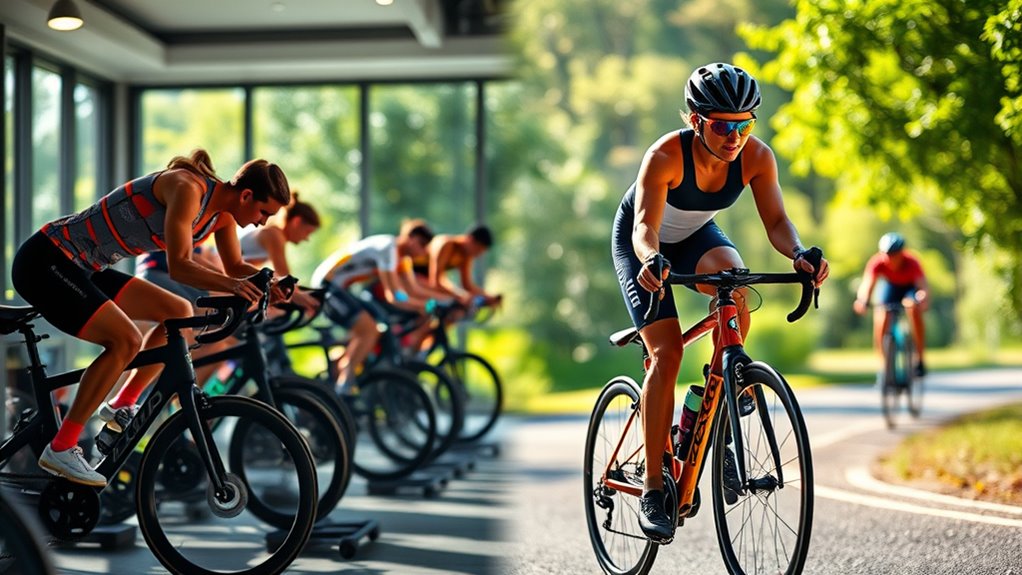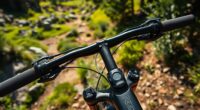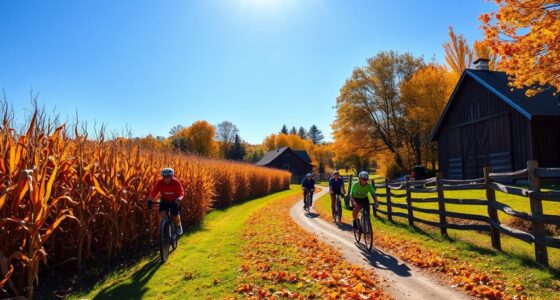To shift smoothly from spin class to outdoor road riding, focus on adjusting your bike setup for comfort and safety, including proper fit and gear. Practice bike handling skills like steering and braking, and always obey traffic rules. Start with short, gradual rides to build confidence, and plan routes carefully using navigation tools. Maintaining proper nutrition and hydration supports your energy levels. Keep improving your routine, and you’ll gain confidence for outdoor cycling—there’s more tips to explore ahead.
Key Takeaways
- Gradually increase outdoor riding distance and terrain complexity to adapt your cycling muscles and handling skills from indoor spin classes.
- Focus on developing consistent pacing, cadence, and smooth gear shifting to replicate the controlled effort of spin workouts.
- Practice proper bike handling, including steering, braking, and cornering, to build confidence on varied road surfaces.
- Incorporate road safety habits: obey traffic signals, use hand signals, and stay alert to traffic and pedestrian interactions.
- Transition with structured training routines, combining spin class endurance with outdoor rides to improve stamina and confidence.
Assessing Your Bike and Equipment Needs
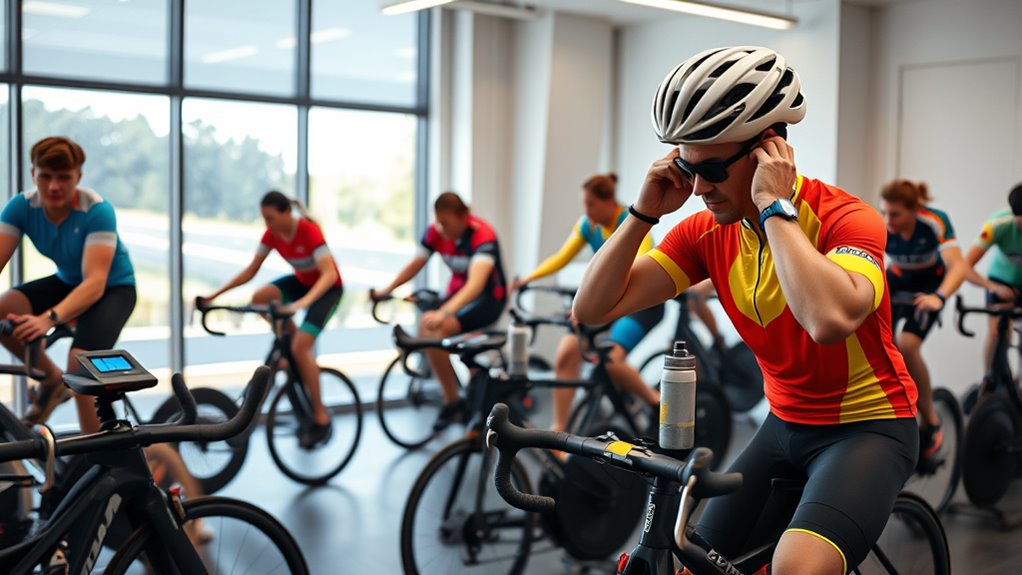
Before hitting the road, you need to determine whether your current bike and gear meet your riding needs. Start by checking your bike fit—if your saddle height, handlebar position, or frame size feels uncomfortable, it can lead to fatigue or injury. Ensuring proper bike fit is essential for comfort and efficiency. Next, evaluate your gear selection; you want items suited for your riding conditions, like appropriate clothing, helmet, gloves, and footwear. If your gear is outdated or unsuitable, upgrading can enhance safety and performance. Make sure your bike is well-maintained, with functioning brakes and gears. Taking the time to assess these aspects now helps prevent issues during your rides and makes your progression from spin class to road cycling smoother and more enjoyable.
Mastering Bike Handling and Control

To ride confidently and safely, mastering bike handling and control is essential. Your bike posture plays a pivotal role; keep your back straight, elbows slightly bent, and stay relaxed. This stance gives you better balance and responsiveness. Focus on proper hand positioning—place your hands comfortably on the handlebars, with your fingers ready to brake or shift. Avoid gripping too tightly, which can cause fatigue and stiffness. Practice smooth steering and gentle corrections to maintain control, especially on turns or uneven surfaces. Look ahead to anticipate obstacles and stay centered over your bike. Developing consistent riding habits can further improve your control and confidence. As you improve, you’ll develop better instinct for handling different situations. Paying attention to your bike handling skills can significantly enhance your overall riding experience.
Understanding Traffic Rules and Road Safety
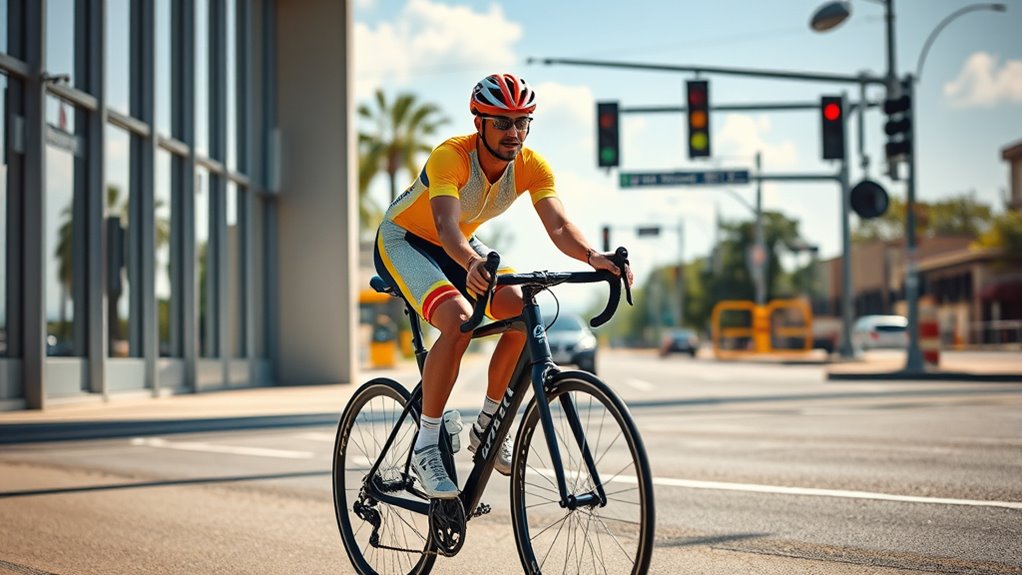
You need to follow traffic signals carefully to stay safe and avoid accidents. Always obey stop signs, lights, and lane markings, even if it feels inconvenient. Practicing safe riding habits, like staying alert and keeping your speed in check, helps you navigate traffic confidently. Understanding vehicle tuning concepts can also help you better maintain your bike for optimal safety and performance. Staying aware of sneaker trends can influence your choice of footwear for comfort and safety during rides. Additionally, being familiar with well-being tips related to physical comfort can enhance your riding experience and prevent fatigue. Incorporating security zone info awareness into your routine can provide extra safety measures when riding in different environments, especially in urban areas. Paying attention to projector technology advancements can also ensure you choose the best equipment for a safe and enjoyable home viewing setup.
Traffic Signal Compliance
Understanding traffic signals is essential for riding safely and legally on the road. You need to follow traffic laws and pay attention to signal timing to avoid accidents. Always look for traffic lights, stop signs, and pedestrian signals, and obey them promptly. Remember, a red light means stop, while a green indicates it’s safe to go. Yellow signals warn you to prepare to stop. Being aware of traffic signal compliance helps prevent violations and ensures a smooth flow of vehicles and pedestrians. Properly interpreting these signals also requires understanding the timing patterns, which can vary depending on the intersection and traffic conditions. Recognizing material differences in signal lights, such as color and shape, can aid in quicker comprehension and response. Many stores have adjusted their hours today to accommodate shopper needs, which underscores the importance of knowing current operating hours. Consistent adherence to these signals also supports the effectiveness of eye patch benefits, as both promote safety and well-being in their respective contexts.
Safe Riding Practices
Practicing safe riding habits starts with knowing and following the traffic rules that apply to cyclists. Always obey traffic signals, ride in designated lanes, and use hand signals to communicate your intentions. Wearing proper cycling apparel, like reflective gear and a helmet, enhances visibility and protection. Make sure your bike is well-maintained—check brakes, tires, and lights regularly—to prevent accidents. Staying predictable on the road helps drivers anticipate your actions, reducing risks. Avoid distractions like headphones and stay alert to your surroundings. Respect pedestrians and other vehicles, and always ride defensively. Being aware of local cycling laws ensures you’re compliant and safe during your rides. Additionally, understanding the importance of home improvement principles such as regular bike maintenance can significantly improve your safety and riding experience. By combining awareness of traffic rules with good bike maintenance, you create a safer riding environment for yourself and others. These practices build confidence and establish responsible cycling habits from the start.
Building Confidence With Gradual Rides
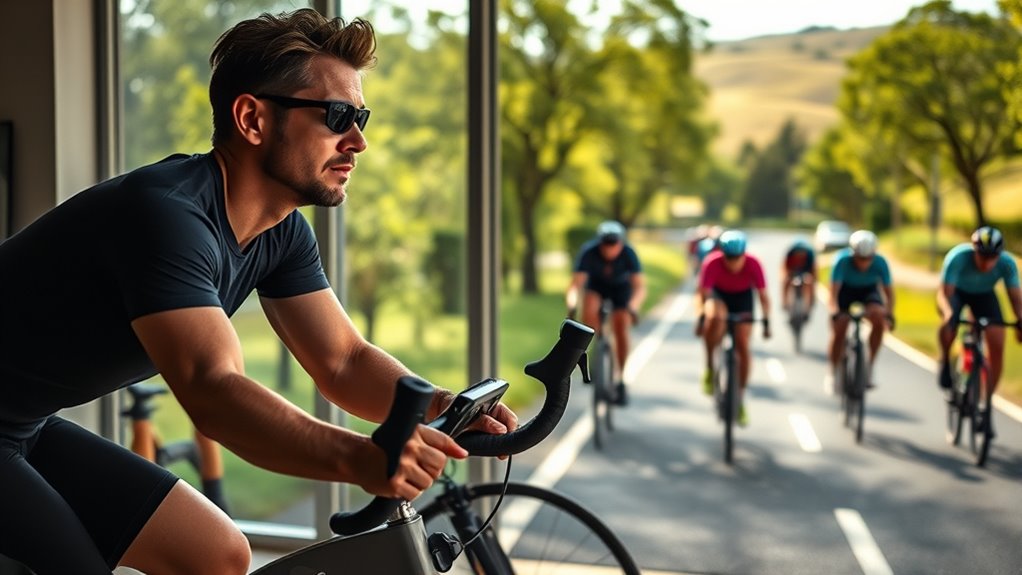
Start with short rides around your neighborhood to build comfort. As you get used to cycling, gradually increase your distance and challenge yourself with new routes. Consistent pacing helps you stay relaxed and confident on each ride. Incorporating gradual progression into your training plan ensures steady improvement and reduces the risk of burnout or injury. Additionally, paying attention to your nutrition and hydration can support sustained energy levels and recovery. Practicing proper bike maintenance can also prevent mechanical issues and keep you safe during rides. Being mindful of state tax implications can also influence your overall financial planning, ensuring you maximize your resources for future rides and other goals. Recognizing how digital distractions can impact focus may also help you stay more engaged and mindful during your training sessions.
Start Small, Progress Steadily
To build confidence as a new cyclist, it’s best to begin with short, manageable rides and gradually increase your distance. Starting with easy routes allows you to get comfortable on your bike and develop good habits. If you’re interested in mountain biking someday, focus on basic skills first, then extend your rides as you gain confidence. Wearing proper cycling apparel helps keep you comfortable and protected during these initial rides. Don’t rush to cover long distances right away; instead, add a few extra miles each week. This steady progression prevents burnout and reduces the risk of injury. Incorporating cycling safety tips into your routine can further boost your confidence and ensure a safer riding experience. Remember, patience is key. Over time, these small, consistent efforts will help you feel more confident on the road or trail, especially when you understand the importance of mental, emotional, and physical well-being in developing a positive cycling experience. Building familiarity with water parks and other recreational spots can also enhance your overall outdoor activity enjoyment, making cycling a more engaging and well-rounded hobby. Additionally, understanding the significance of community engagement can motivate you to stay committed to your cycling journey.
Practice Consistent Pacing
Maintaining a steady pace during your rides helps build confidence and keeps you comfortable over time. Focus on cadence consistency to develop smooth, efficient pedaling. When you track your cadence, you become more aware of your pacing, ensuring you don’t start too fast or slow down unexpectedly. Pacing awareness allows you to gauge your effort without overexerting yourself, especially during longer rides. Start with a moderate, sustainable pace and gradually increase intensity as you gain confidence. Use a cycling computer or smartphone app to monitor your cadence and pace. Over time, this consistency helps you feel more in control and reduces the chance of burnout. Remember, the goal is to ride comfortably while gradually challenging yourself.
Adjusting Your Nutrition and Hydration for Outdoor Cycling

When cycling outdoors, adjusting your nutrition and hydration is essential to sustain energy and prevent fatigue. Proper fueling helps you perform at your best and recover faster. Focus on staying hydrated with electrolyte drinks, which replenish lost minerals and maintain stamina. For quick energy, carry energy gels that are easy to consume on the go. To optimize your nutrition, consider these tips:
- Drink electrolyte drinks regularly, especially in hot weather
- Use energy gels during long rides for a quick boost
- Eat small, carbohydrate-rich snacks beforehand
- Stay consistent with hydration and fueling throughout your ride
Planning Your Routes and Using Navigation Tools
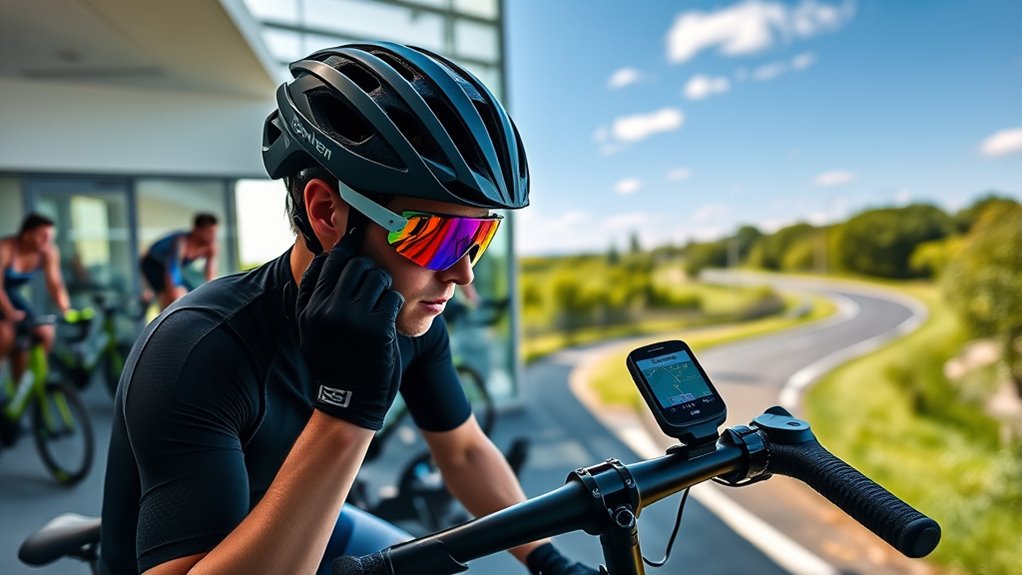
Planning your routes carefully and utilizing navigation tools can substantially enhance your outdoor cycling experience. Effective route planning helps you choose safe, enjoyable paths that match your skill level and goals. Use navigation apps like Strava, Komoot, or Google Maps to plot out your rides before heading out. These tools provide detailed maps, turn-by-turn directions, and real-time updates, making it easier to stay on track and avoid getting lost. Consider the terrain, traffic, and rest stops when planning your route to ensure a comfortable ride. Familiarize yourself with your navigation app’s features to maximize its benefits. Proper planning and smart use of navigation tools give you confidence, improve your efficiency, and let you focus on enjoying your ride.
Developing a Consistent Training Routine

Establishing a consistent training routine is essential for building your cycling skills and endurance over time. Regular rides help improve your cycling cadence, making pedaling smoother and more efficient. To stay on track, set specific days for training and gradually increase intensity. Focus on maintaining proper bike maintenance to prevent breakdowns and ensure safety. Incorporate variety in your routine, mixing endurance rides with interval training. Keep a training log to monitor progress and identify areas for improvement. Remember, consistency is key; even short, frequent sessions beat sporadic long rides. Prioritize your recovery and listen to your body to avoid injury. Developing a routine keeps you motivated and steadily advances your riding, whether you’re training for a race or just enjoying the sport.
Frequently Asked Questions
How Do I Choose the Right Road Bike for Beginners?
When choosing the right road bike, focus on a proper bike fit to ensure comfort and efficiency. As a beginner, you should consider lightweight frame materials like aluminum or carbon for easier handling. Test different sizes and styles to find what feels best for your riding style. Remember, a well-fitted bike with suitable frame materials makes your shift smoother and keeps you motivated on those long rides.
What Gear Should I Carry During Outdoor Rides?
Thinking about what gear to carry during outdoor rides? Ironically, you’ll want to pack light, but also bring along essential cycling accessories. An emergency kit is your best friend—think spare tube, multi-tool, and a mini pump. Add some water, snacks, and a phone for safety. While it’s tempting to overpack, remember, a well-chosen emergency kit and some basic gear keep you prepared without turning your ride into a luggage load.
How Can I Stay Motivated to Ride Outdoors Regularly?
To stay motivated to ride outdoors regularly, join local cycling communities where you can share your passion and find encouragement. Set small, achievable goals to track your progress and keep your enthusiasm high. Remember, riding with others makes it more fun and accountable. Embracing the social aspect and celebrating your milestones will make outdoor cycling a rewarding habit you look forward to every day.
What Are Common Beginner Mistakes When Transitioning From Spin Class?
When shifting from indoor cycling, you might make common beginner mistakes like neglecting outdoor cycling safety and improper pedal technique tips. Focus on practicing smooth pedal strokes and maintaining proper body positioning to avoid fatigue or injury. Remember to check your bike’s fit and gear before heading out. This helps you stay comfortable and safe, boosting your confidence on the road and making your transition smoother and more enjoyable.
How Do I Handle Unexpected Obstacles on the Road?
Like maneuvering a river’s unpredictable currents, handling unexpected obstacles on the road requires calm and quick thinking. Stay alert with road hazard awareness, scanning ahead for debris, potholes, or animals. Use obstacle avoidance techniques like shifting your weight, adjusting your speed, and steering smoothly around hazards. Keep your hands steady on the handlebars and maintain a flexible body stance. Practice these skills regularly so you’re ready when surprises arise, ensuring a safe, confident ride.
Conclusion
Switching from spin class to road riding might feel like stepping into a different century, but with patience and practice, you’ll soon handle your bike with the grace of a 21st-century cyclist. Remember, just as a knight trains for battle, your confidence grows with each ride. Keep your gear ready, stay alert, and enjoy the journey—think of it as your personal odyssey, turning every pedal stroke into a step toward mastery.
